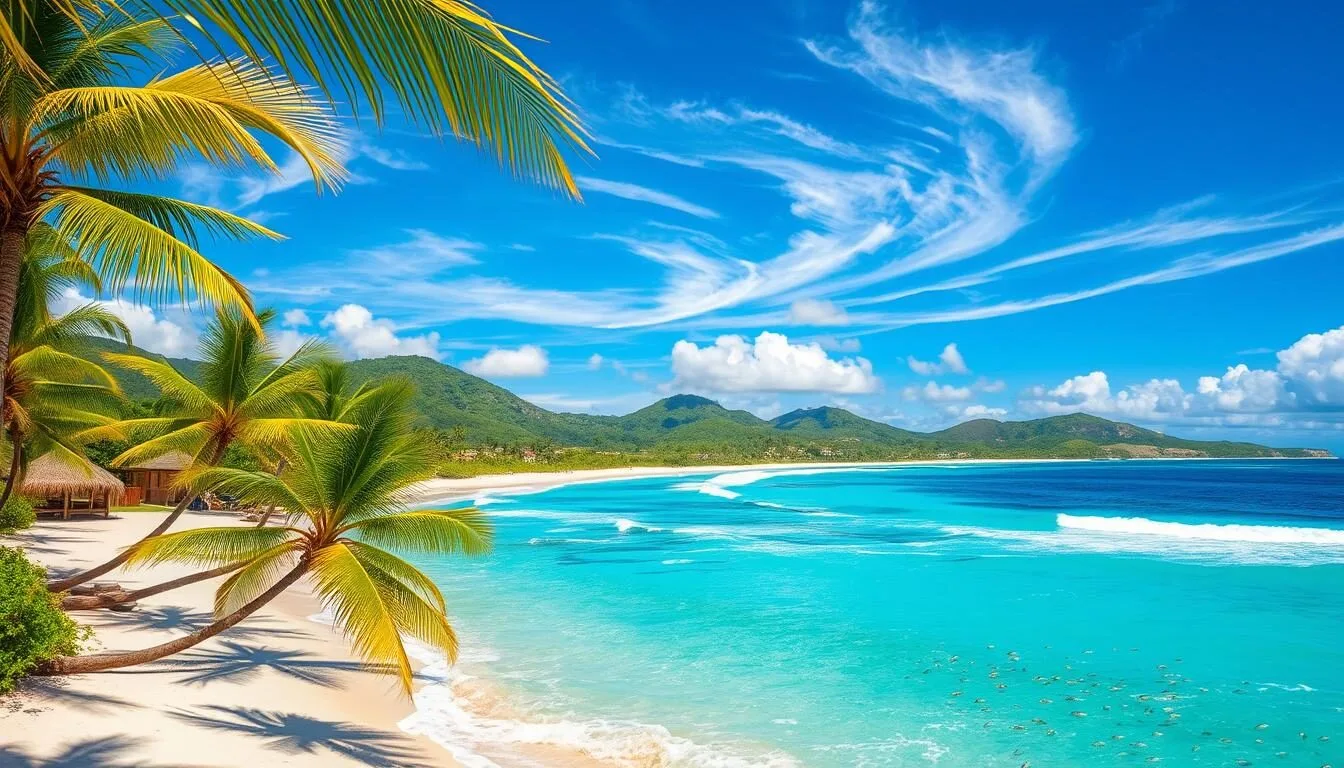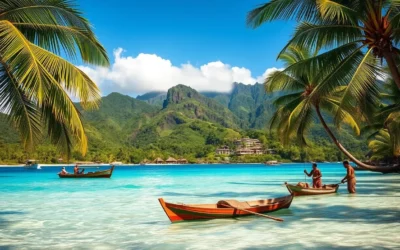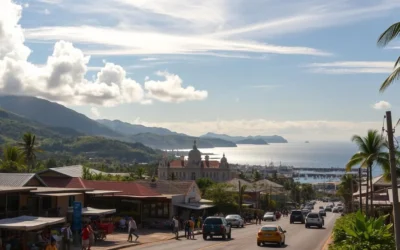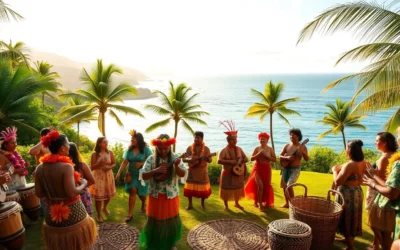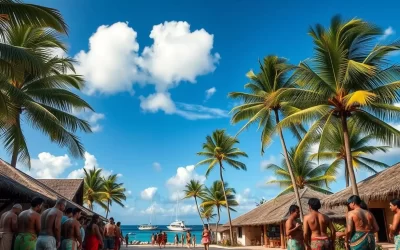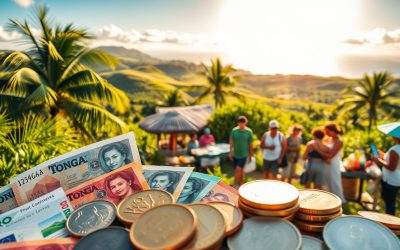✓ Accommodations✓ Flights✓ Rental Cars✓ Tours & Activities
Did you know that Tonga’s tropical climate makes it an ideal destination for travelers seeking a unique South Pacific experience? With its pristine beaches, crystal-clear waters, and authentic Polynesian culture, this island kingdom is a gem waiting to be explored.
Understanding the weather patterns in Tonga is crucial for planning your trip. The islands experience two distinct seasons that significantly impact your travel experience. By determining the best time to visit, you can enjoy optimal conditions for activities like whale watching and make the most of your time in this tropical paradise.
This comprehensive guide will help you navigate Tonga’s climate, ensuring your trip is nothing short of extraordinary.
Discovering Tonga’s Tropical Paradise
Tonga, an archipelago of 169 islands, is a haven for those seeking an unspoiled tropical experience. You can explore the diverse landscapes and attractions across its main island groups: Tongatapu, Vava’u, Ha’apai, and ‘Eua.
Geography and Island Overview
Tonga’s islands are spread across the South Pacific, with only 36 inhabited, offering a true sense of discovery and isolation. The islands have distinct characters, from the main island Tongatapu to the picturesque Vava’u, known for its whale watching opportunities, and Ha’apai, ideal for those seeking tranquility. Understanding Tonga’s geography helps you plan your trip based on your interests and the prevailing weather conditions.
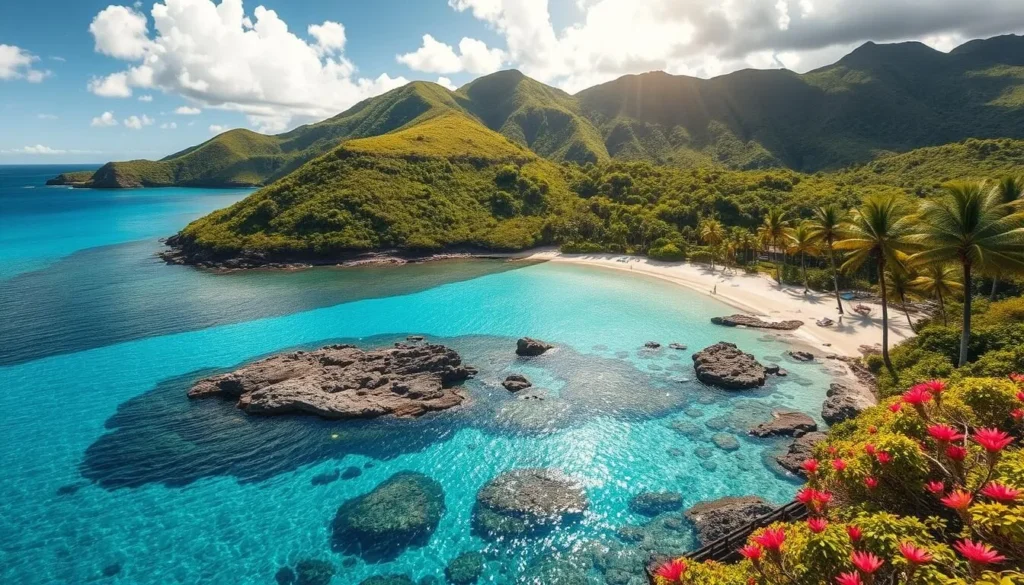
Why Weather Matters for Your Tongan Adventure
The weather significantly impacts your Tongan adventure, affecting island accessibility and activity availability. Seasonal weather patterns influence whale watching, snorkeling, and diving conditions. Knowing when to visit ensures you experience Tonga at its best, with optimal weather conditions enhancing your tropical climate experience.
Understanding Tonga’s Climate
As you prepare for your Tongan adventure, grasping the nuances of its climate will enhance your travel plans. Tonga’s climate is characterized by warm temperatures year-round, making it an attractive destination for travelers.
Tropical Climate Essentials
Tonga enjoys a tropical climate that is warm and inviting throughout the year. The islands experience two distinct seasons: the dry season from May to November and the wet season from December to April. Understanding these seasonal patterns is essential for planning activities and making the most of your time in Tonga.
The tropical climate means you’ll experience high humidity at times, particularly during the wet season when it can feel quite oppressive. However, the dry season offers cooler temperatures and lower humidity, making it a comfortable period to visit.
Year-Round Temperature Patterns
Tonga’s temperatures remain relatively stable throughout the year, with average temperatures ranging from 18°C (64°F) to 35°C (95°F). The lows in Tonga do not usually fall below 18°C, and the highs do not get above 35°C, creating generally pleasant conditions for tourists. 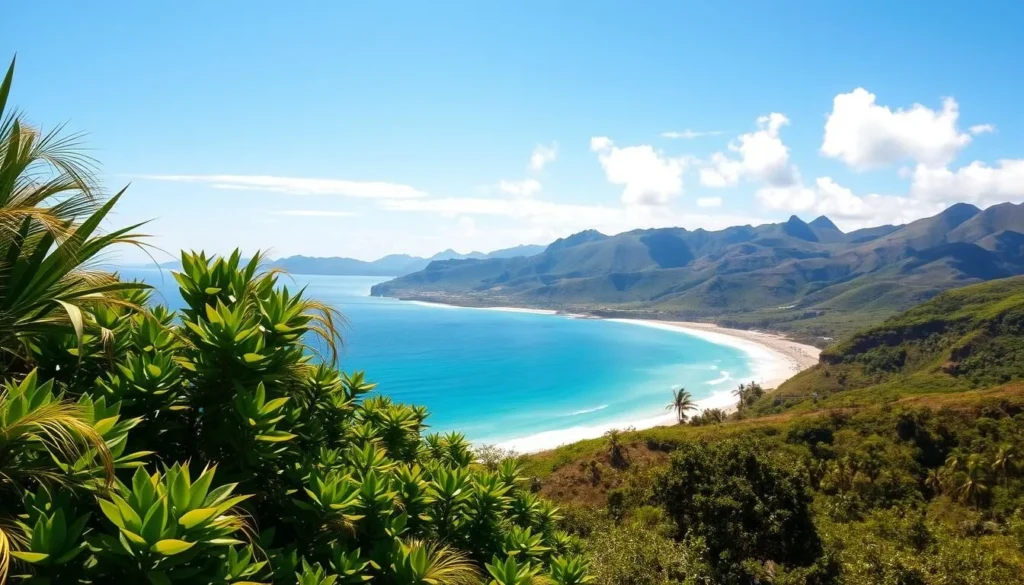
The stable temperature patterns make Tonga a welcoming destination regardless of when you choose to visit. Year-round warm ocean temperatures also make water activities enjoyable whenever you visit, though visibility and conditions vary by season.
Tonga’s Two Distinct Seasons
Understanding Tonga’s two main seasons is crucial for planning a memorable trip. Tonga’s weather is defined by two primary seasons that create distinctly different travel experiences throughout the year.
The Dry Season: May to November
The dry season, spanning from May to November, brings lower humidity, cooler temperatures, and significantly less rainfall, making it the preferred time for most visitors. During this period, you’ll enjoy more comfortable exploring conditions with daytime temperatures typically ranging from 24°C to 29°C (75°F to 84°F).
- Comfortable temperatures for outdoor activities
- Less rainfall and lower humidity
- Ideal time for swimming with humpback whales (July to October)
The Wet Season: December to April
The wet season features higher temperatures, increased humidity, and regular rainfall, often in the form of brief but intense showers. Wet season temperatures typically range from 25°C to 35°C (77°F to 95°F), with the added humidity making it feel even warmer.
- Lush landscapes due to increased rainfall
- Fewer tourists, potentially lower prices
- Risk of tropical cyclones between January and March
Rainfall and Humidity Levels
Understanding rainfall and humidity levels is crucial for planning a comfortable trip to Tonga. The islands experience a tropical climate with significant variations in rainfall and humidity throughout the year.
Monthly Rainfall Patterns
Tonga’s rainfall varies significantly across the months. The wet season, from December to April, receives approximately 60-70% of the annual precipitation. January and February are the wettest months, with average rainfall exceeding 250mm. In contrast, the dry season, especially June through August, sees a dramatic drop in rainfall, averaging around 70-100mm monthly. Rainfall during the wet season often comes in short, intense bursts, allowing for activities between showers.
Managing Humidity During Your Visit
Humidity levels in Tonga fluctuate seasonally. The wet season brings high humidity, often exceeding 80%, creating a sticky atmosphere. In contrast, the dry season offers more comfortable humidity levels, typically between 60-75%. To manage the humidity, plan your activities for early morning or late afternoon to avoid the most uncomfortable periods. Accommodations with good ventilation or air conditioning are particularly valuable during the humid months from December to March.
| Month | Average Rainfall (mm) | Average Humidity (%) |
|---|---|---|
| January | 280 | 85 |
| February | 260 | 84 |
| July | 80 | 65 |
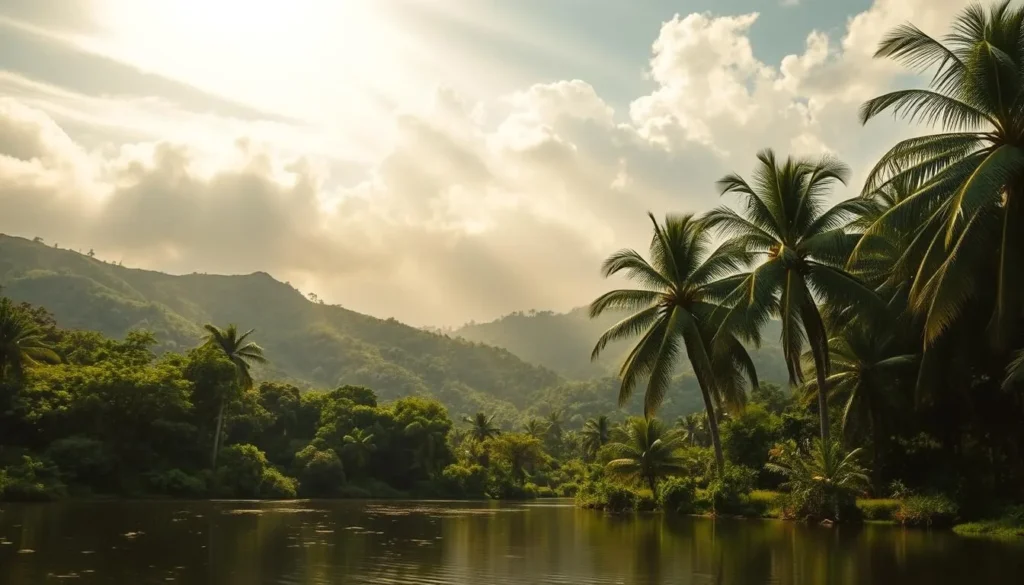
Sunshine Hours and Cloud Cover
Tonga’s climate is characterized by generous amounts of sunshine throughout the year. The country’s tropical location ensures that it receives a significant amount of sunshine daily, making it an ideal destination for those who love basking in the sun.
Sunniest Months in Tonga
The sunniest period in Tonga occurs during the dry season, with months like June through September offering the most reliable sunshine and clearest skies. You can expect 7-9 hours of direct sunshine per day during these peak sunny days, perfect for engaging in beach activities and water sports.
Cloudier Periods to Consider
In contrast, the wet season brings increased cloud cover, with months like December through March averaging 5-6 hours of sunshine daily interspersed with cloudy periods. Even during these cloudier days, the tropical location means that temperatures remain warm, and water activities are still enjoyable.
| Season | Months | Average Sunshine Hours |
|---|---|---|
| Dry Season | June – September | 7-9 hours |
| Wet Season | December – March | 5-6 hours |
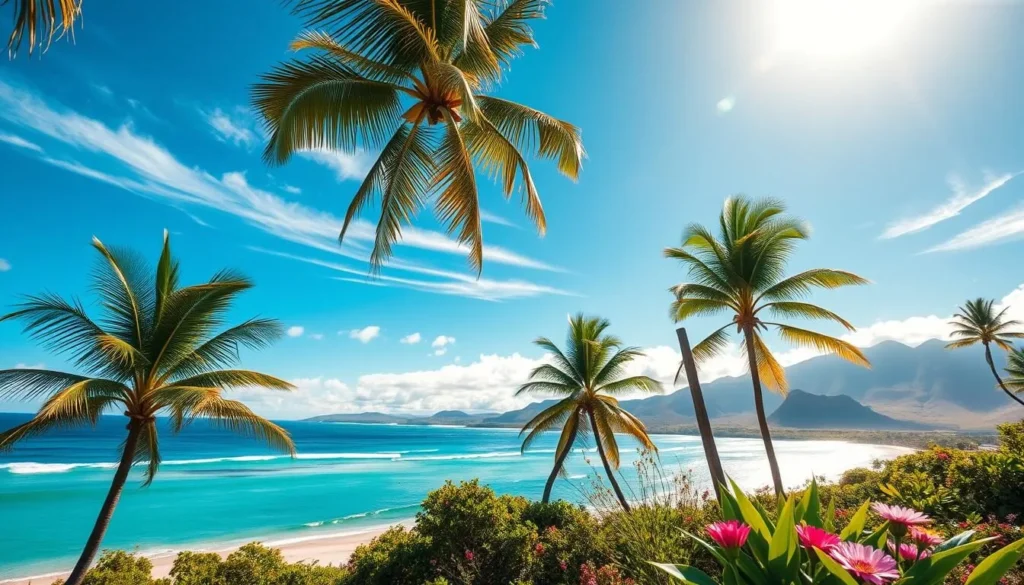
Wind Conditions Throughout the Year
As you plan your Tongan adventure, it’s essential to consider the wind conditions. Tonga’s wind patterns vary throughout the year, significantly impacting your island experience.
Trade Winds and Their Impact
The southeast trade winds primarily influence Tonga’s wind patterns, varying in intensity throughout the year. During the dry season (May to November), these winds are most consistent, creating refreshing breezes that help moderate the tropical heat. June through August typically experiences the strongest and most reliable trade winds, making these months ideal for sailing and windsurfing.
Calmer Periods for Water Activities
During the wet season, especially December through February, the trade winds weaken and become less predictable. The calmest water conditions generally occur during the transition months (April/May and October/November) when winds are moderate. Early mornings throughout the year typically offer the calmest conditions for activities like paddleboarding, kayaking, and snorkeling.
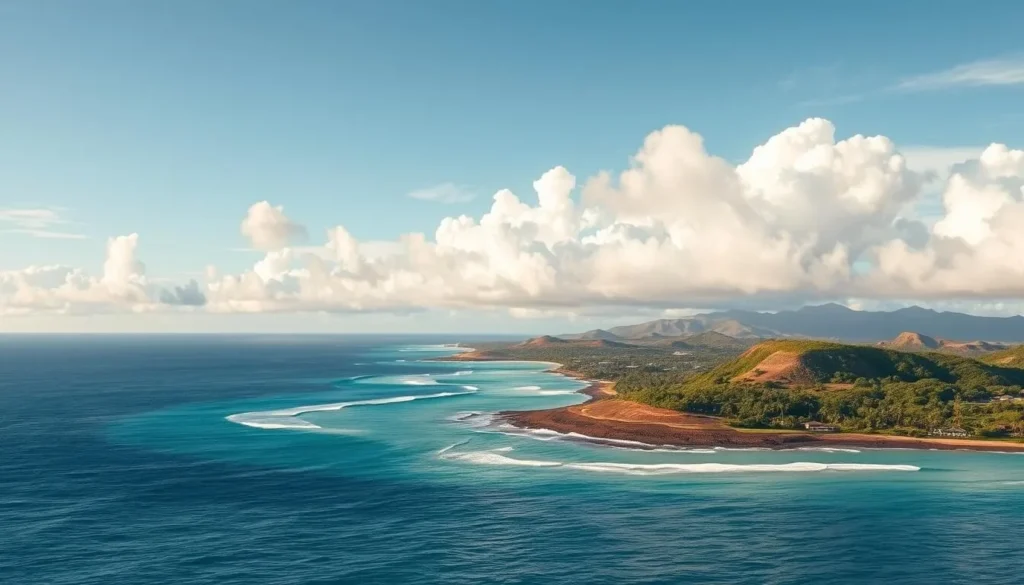
Ocean Temperatures and Water Activities
Tonga’s waters are invitingly warm, making them ideal for swimming, snorkeling, and other water activities. The ocean temperatures around Tonga remain warm throughout the year, creating a perfect environment for various aquatic pursuits.
Best Months for Swimming and Snorkeling
The warmest water temperatures occur during the wet season (December to April), reaching 27-29°C (81-84°F), perfect for extended periods of swimming and snorkeling. During the dry season (May to November), water temperatures cool slightly to 24-26°C (75-79°F), still very comfortable for all water activities.
- The best water temperatures for swimming are found from December to April.
- Snorkeling is excellent during the dry season due to clearer waters.
Water Visibility and Marine Life Considerations
Water visibility varies significantly by season. The dry months, especially June through September, offer exceptional clarity of 20-30 meters (65-100 feet). The best months for snorkeling and diving are July through October, when you’ll enjoy a combination of good visibility, calm seas, and comfortable water temperatures.
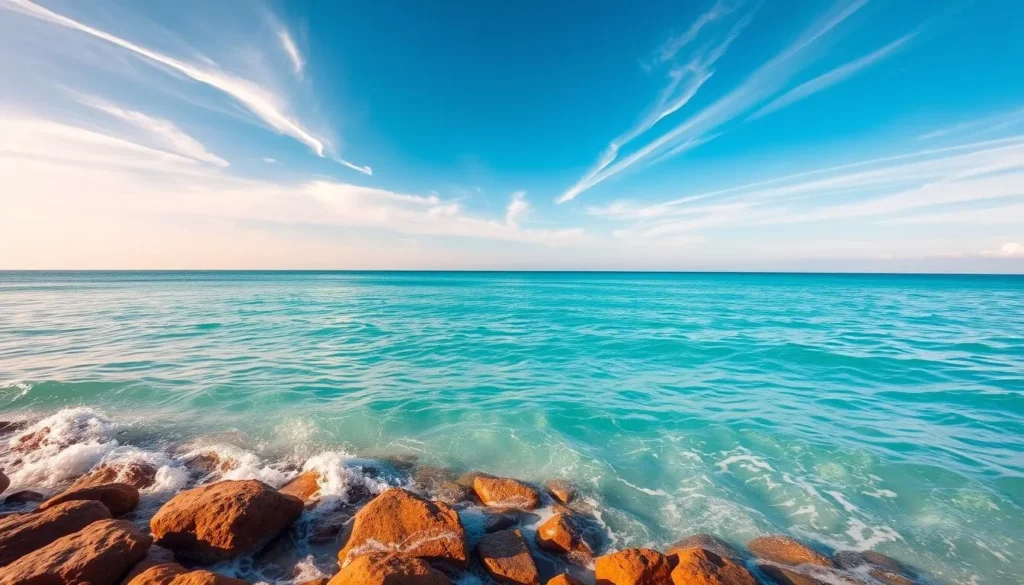
- Marine life is abundant year-round, with July to October being prime time for whale watching.
- Water activities like kayaking and paddleboarding are best during calmer wind periods.
Tonga: Best Months for a Weather-Savvy Trip
Planning a trip to Tonga requires understanding the best months to visit for a weather-savvy adventure. The ideal time to visit is between May and November, coinciding with the dry season, which offers less hot and humid conditions.
July to October: Optimal Weather Conditions
The period from July to October is considered the peak season in Tonga, offering optimal weather conditions with dry weather, comfortable temperatures, and minimal rainfall. This time is perfect for activities like snorkeling and diving, with excellent visibility. Moreover, it coincides with the humpback whale season, allowing visitors to swim with these magnificent creatures.
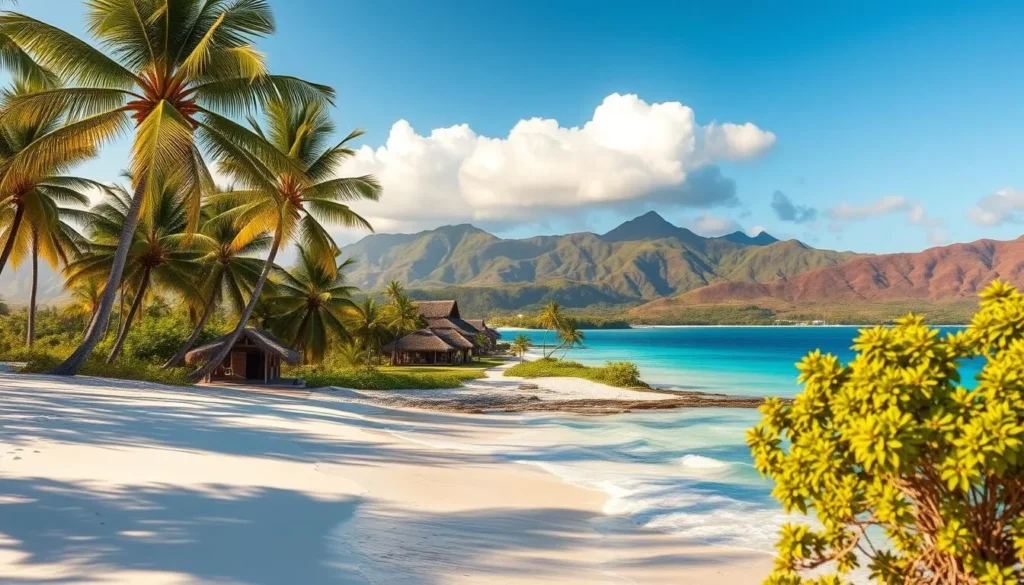
May, June, and November: Shoulder Season Benefits
The shoulder months of May, June, and November provide a great balance between favorable weather and fewer tourists. May and June see decreasing rainfall and humidity as the wet season transitions to the dry season. November marks the beginning of the transition to the wet season but still offers predominantly dry conditions. These months are ideal for travelers seeking a more peaceful experience and potentially lower prices.
Weather Differences Between Tongan Islands
As you plan your trip to Tonga, understanding the weather differences between its islands is crucial. Tonga’s main island groups each have subtle but important weather variations that can impact your travel experience throughout the year.
Tongatapu’s Climate Profile
Tongatapu, the main island and home to the capital Nuku’alofa, typically experiences slightly cooler temperatures than the northern islands, with average highs of 26-29°C (79-84°F). As the southernmost main island, Tongatapu receives more defined seasonal changes and slightly higher rainfall during the wet season compared to other island groups. This makes it essential to pack accordingly and plan activities based on the season.
Vava’u, Ha’apai, and ‘Eua Weather Variations
The Vava’u island group enjoys more consistent weather patterns with less temperature variation throughout the year, making it ideal for yachting and water activities. The Ha’apai group experiences slightly warmer temperatures and less rainfall than Tongatapu, with exceptional weather during the dry season. ‘Eua, known as the “forgotten island,” has a unique microclimate influenced by its higher elevation and forests, sometimes experiencing cloud cover and brief showers even during the dry season. Understanding these regional variations helps you select the ideal islands to visit based on your travel dates and preferred activities.
Planning Activities Around Tonga’s Weather
Tonga’s tropical climate, with its distinct wet and dry seasons, dictates the best times for different activities. Understanding these seasonal variations is key to maximizing your experience in this Pacific island nation.
Best Times for Whale Watching
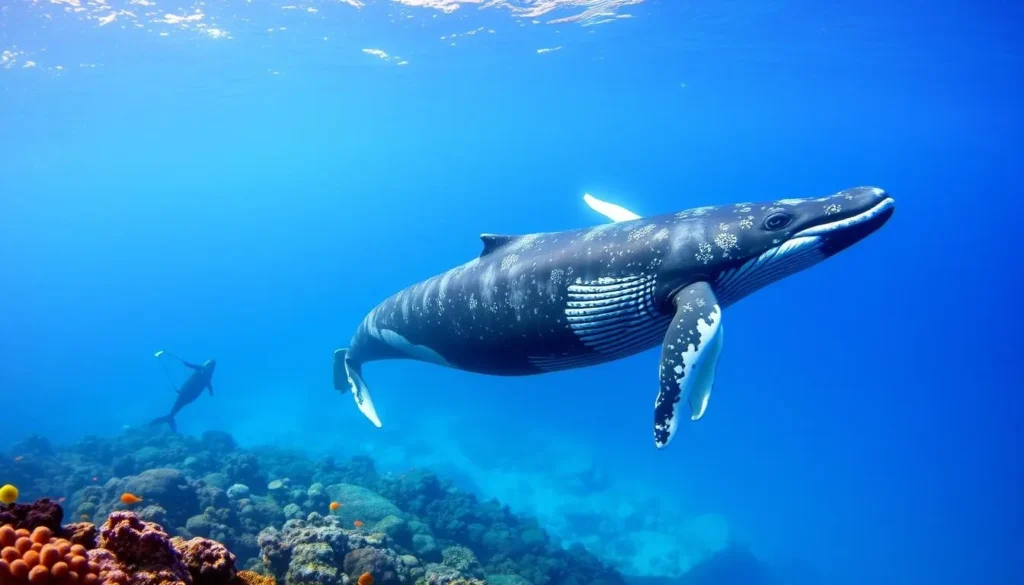
The best time for whale watching in Tonga is from July to October, with August and September being the peak months. During this period, humpback whales migrate to Tongan waters for breeding and calving, offering an incredible opportunity to swim with these magnificent creatures.
Ideal Weather for Water Sports and Beach Activities
The dry season, from May to November, is ideal for water sports like snorkeling and diving due to excellent visibility, often exceeding 30 meters. For surfing, the wet season (December to April) is more suitable due to larger swells. Water activities such as kayaking and paddleboarding are best enjoyed during the calmer morning hours, particularly during the shoulder season.
Cultural Events and Weather Considerations
Tonga’s rich cultural heritage is showcased through various festivals and events throughout the year. You can experience the vibrant culture of the islands by participating in these events.
Tongan Festivals Throughout the Year
Tonga’s cultural calendar features numerous festivals, with the Heilala Festival being the most significant. It takes place in June/July during the dry season, featuring parades, dancing, and cultural performances. Weather considerations are crucial when planning to attend these outdoor events.
Sunday Observances and Weather Planning
Sunday is a sacred day in Tonga, with strict observances that prohibit most activities. You can visit Pangaimotu Island, one of the few places where restrictions are relaxed, to enjoy the beach and snorkelling. Planning your time on the islands around these observances will enhance your experience.
Practical Travel Considerations
When planning your trip to Tonga, it’s essential to consider practical travel considerations to make the most of your time. Understanding the local currency, accommodation options, and flight availability can significantly impact your travel experience.
Pricing and Crowds Throughout the Year
Tonga experiences distinct high and low seasons that affect pricing, availability, and the overall travel experience. The high season, which coincides with the dry season (May to November), sees peak prices and visitor numbers, particularly during the whale watching months of July to September. You can expect accommodation rates to vary by 20-30% between high and low seasons, with the best values found during the shoulder months of May, June, and November.
For your accommodation, be prepared for higher prices during peak season. Planning ahead can help you secure better rates.
Flight Availability and Weather Impacts
Flight availability to Tonga is limited, with most international connections coming through Fiji, New Zealand, or Australia. It’s crucial to book in advance during peak periods. Weather can impact flight reliability, particularly during the cyclone season (January to March), when delays or cancellations are more common. Inter-island transportation is more reliable during the dry season. Consider purchasing travel insurance that covers weather-related disruptions, especially if you’re visiting during the wet season.
Packing Tips Based on Tonga’s Weather
To make the most of your Tongan trip, it’s essential to pack wisely, considering the island’s climate and activities. A well-prepared traveler can enjoy the beautiful landscapes and cultural experiences without the hassle of inappropriate clothing.
Essential Items Year-Round
Regardless of the season you visit Tonga, there are certain essentials you should always pack. Lightweight, breathable clothing made from natural fibers like cotton or linen is a must, as it dries quickly in the humid environment. Sun protection is also crucial; include a high-SPF sunscreen (reef-safe preferred), sunglasses, and a wide-brimmed hat to shield yourself from the tropical sun. Modest clothing that covers shoulders and knees is important for cultural respect when visiting villages or attending church services.
| Item | Purpose |
|---|---|
| Lightweight clothing | Comfort in humid temperatures |
| Sun protection gear | Protection from the tropical sun |
| Modest clothing | Cultural respect during village visits |
Seasonal Additions to Your Packing List
For the dry season (May to November), consider packing a light sweater or jacket for cooler evenings, especially during the coolest months of June to August. In contrast, the wet season (December to April) requires a lightweight, packable rain jacket or poncho, as well as quick-dry clothing that won’t stay damp in the higher humidity. These tips will help you navigate Tonga’s climate with ease.
- Sturdy sandals for beach and boat activities
- Closed shoes for hiking or exploring rugged terrain
- A dry bag or waterproof case for electronics and valuables, particularly useful during the wet season or for boat trips
By packing strategically for your Tongan trip, you’ll enhance your comfort and enjoyment throughout your journey.
Weather Monitoring Resources for Tonga
Your Tongan getaway will be more enjoyable if you’re prepared for the local weather conditions. Staying informed about Tonga’s weather before and during your trip is vital to making the most of your time on the islands.
Reliable Weather Forecasts for the Islands
For accurate and up-to-date weather information, rely on the Tonga Meteorological Service (www.met.gov.to). They provide local forecasts and weather warnings specific to the Tongan islands. Global weather services like AccuWeather and Weather Underground can also be useful for extended forecasts, although they may lack the local accuracy of Tongan sources.
Understanding Weather Patterns Before Your Trip
To plan effectively, understand typical weather patterns for your travel dates. This knowledge allows you to pack appropriately and plan activities that align with expected conditions. During cyclone season (November to April), regularly monitoring weather updates is particularly important, as conditions can change rapidly. Utilize mobile weather apps with offline functionality and satellite imagery services to stay informed, especially when traveling to outer islands.
Month-by-Month Weather Guide to Tonga
Understanding Tonga’s month-by-month weather guide can help you make the most of your trip. Tonga experiences two distinct seasons: the dry season and the wet season.
Dry Season Months (May-November)
During the dry season, Tonga enjoys favorable weather conditions across various months.
- May marks the beginning of the dry season with decreasing rainfall and humidity, and average temperatures of 24-28°C (75-82°F).
- June to August are the coolest months with low humidity and minimal rainfall, ideal for whale watching starting in July.
- September and October offer warm temperatures, reliable sunshine, and excellent water visibility.
- November transitions toward the wet season but still maintains generally favorable conditions.
Wet Season Months (December-April)
The wet season brings rising temperatures and increased humidity throughout the year.
- December sees the official start of the wet season with more frequent rain showers.
- January and February are the wettest months with high humidity and a risk of tropical cyclones.
- March and April begin the transition back to the dry season with gradually decreasing rainfall.
Conclusion: Making the Most of Your Tongan Weather Experience
Embracing Tonga’s laid-back island pace means understanding and adapting to its weather conditions. The best time to visit Tonga ultimately depends on your priorities, whether that’s optimal weather, specific activities like whale watching, or finding the best value for your trip.
For most travelers, the period from July to October represents the ideal balance of favorable weather and exceptional water conditions. Being flexible with your daily plans allows you to adapt to changing weather conditions, making the most of your experience on the islands.
Regardless of when you visit, Tonga’s warm hospitality, stunning natural beauty, and rich cultural heritage ensure a memorable experience that goes beyond weather considerations. With proper planning, your Tongan adventure will be a highlight of your travel trip, leaving you with lasting memories of this unique South Pacific kingdom.
The above is subject to change.
Check back often to TRAVEL.COM for the latest travel tips and deals.
